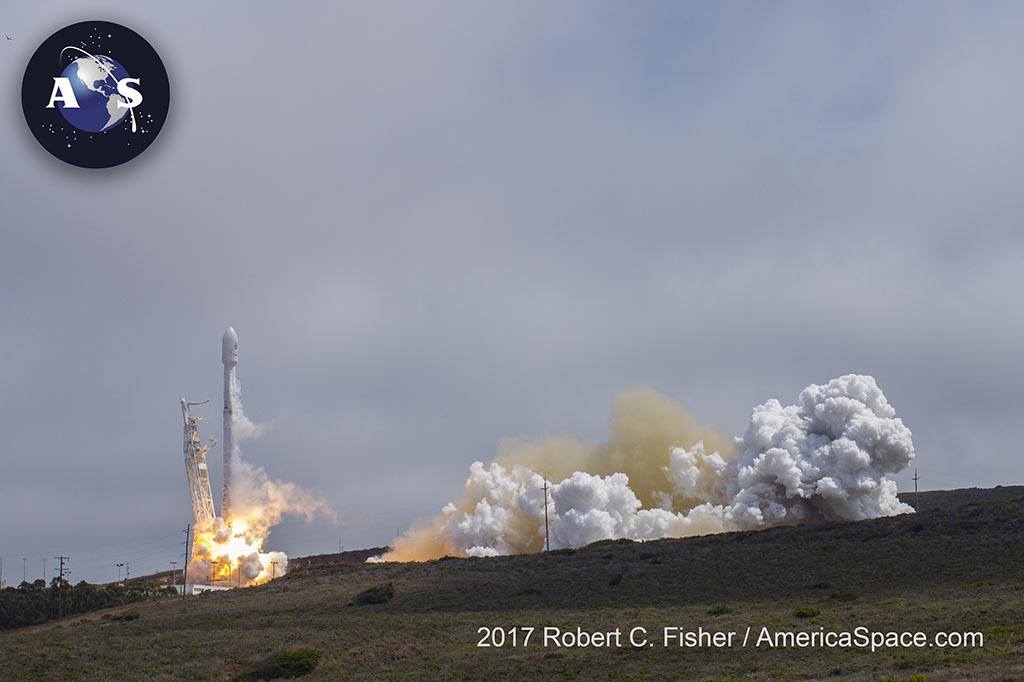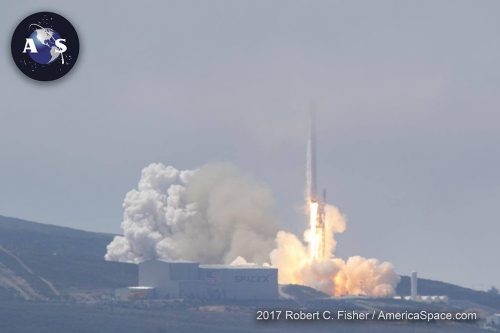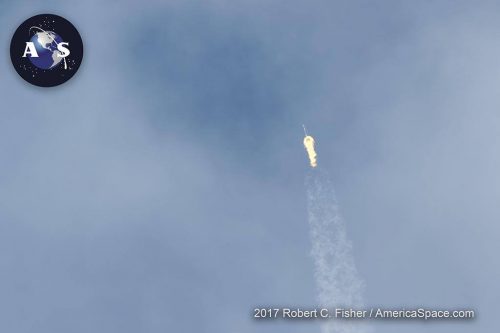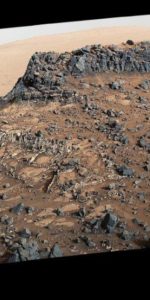
SpaceX successfully delivered one of its smallest primary payloads into orbit, early Thursday, 24 August, when a mammoth Upgraded Falcon 9 booster lifted off from Space Launch Complex (SLC)-4E at Vandenberg Air Force Base, Calif., carrying Taiwan’s Formosat-5 payload for Earth imagery and atmospheric research. Weighing only 1,050 pounds (475 kg), Formosat-5—the first fully home-grown remote-sensing satellite program for the National Space Organisation (NSPO) of Taiwan—rose from Earth at 11:51 a.m. PDT. It was boosted into a Sun-synchronous orbit at an altitude of 450 miles (720 km).
It might have been expected that with a relatively low-energy launch profile, this launch might have met all the conditions for the Upgraded Falcon 9 first stage to make the first “land” landing at Vandenberg. However, SpaceX notified AmericaSpace that, although a landing pad is fully assembled and ready for operations at the West Coast launch site, the Federal Aviation Administration (FAA) approvals for land landings are not yet in place. As such, today’s booster core made its way back to Earth and alighted on the expansive deck of the Autonomous Spaceport Drone Ship (ASDS), nicknamed “Just Read the Instructions”, situated in the Pacific Ocean. This was SpaceX’s third successful landing on JRTI and brings another flight asset safely home for future re-use.
Somewhat later than has ordinarily been the case, JRTI was drawn out to sea from Port of Los Angeles at about 9:30 a.m. PDT on Tuesday, 22 August. Providing the muscle was the NRC Quest offshore supply vessel, which positioned the drone ship at an approximate distance of 186 miles (300 km) off the California coastline. This was the first movement of the NRC Quest and JRTI since early July, when they returned to port having supported the landing of Upgraded Falcon 9 hardware after the second Iridium NEXT mission. All told, 2017 has been a busy year for JRTI, which has now successfully recovered three Falcon 9 cores in just eight months.

Thursday’s success is also an indicator of the growing maturity of SpaceX’s oceanic landing processes and procedures. The Hawthorne, Calif.-based organization conducted several “controlled oceanic touchdowns” in 2014, followed by four mixed-success efforts to physically land on the East Coast-based ASDS, “Of Course I Still Love You”, throughout 2015. The first wholly successful drone ship landing came in April 2016 and, since then, and including today’s touchdown, no fewer than nine Upgraded Falcon 9 first stages have been brought smoothly back to the ASDS deck. Added to this tally, six other booster cores have accomplished “land” landings on Landing Zone (LZ)-1 at Cape Canaveral Air Force Station, Fla., most recently last week’s CRS-12.
Backdropping the Formosat-5 launch campaign has been an ongoing effort to contain a wildland fire, which broke out on South Vandenberg last Saturday. Named the “Spring Canyon Fire”, it affected an area of some three acres (12,000 square meters), but later increased to 10 acres (40,500 square meters). Initially attended by seven fire engines with hand-crews, bulldozers and airborne assets, additional personnel provided support over the weekend, including hotshot crews from Santa Barbara County and the U.S. Forest Service. It was noted that the fire—which was fully contained and extinguished by the weekend’s close—did not pose any risks to the ongoing Formosat-5 campaign.
The weather outlook for Thursday’s opening launch attempt was predicted to be 90-percent favourable, with a slight risk of ground winds forcing a delay. “During the lead-up to launch day, a low-pressure region will move into the central coast and pass over the range during the countdown,” noted the L-2 weather briefing, posted Tuesday by the 30th Space Wing. “The impact of this low will lift and thicken the marine layer, while keeping winds light at the surface. Winds will be out of the northwest through the count, with T-0 winds out of the west-northwest at 10-15 knots.” It was stressed that the outlook would improve to 100-percent favorable in the event of a 24-hour launch scrub to Friday.
The nine Merlin 1D+ engines of the Upgraded Falcon 9’s first stage were successfully ignited at SLC-4E last weekend, in the customary pre-launch Static Fire Test. The booster passed through the test with flying colors and was subsequently returned to a horizontal configuration and returning to its assembly building, for the integration of the bullet-like payload fairing which houses Formosat-5. The 230-foot-tall (70-meter) stack was then returned to SLC-4E, ahead of formal countdown activities.
Heading into Thursday’s launch attempt, SpaceX teams pressed ahead with loading a highly refined form of rocket-grade kerosene (known as “RP-1”) aboard the Upgraded Falcon 9, followed by cryogenic liquid oxygen. The terminal countdown autosequencer was initiated at T-10 minutes, after which the Merlin 1D+ engines were chilled, prior to ignition, and the vehicle entered “Startup” at T-60 seconds. The launch pad’s deluge system began to flood SLC-4E with water to reduce the reflected energy and at T-3 seconds the nine Merlins roared to life, ramping up to a combined 1.5 million pounds (680,000 kg) of thrust.

As the lightest primary payload ever orbited by a member of the Falcon 9 family, the sense of “overkill” was palpable, for Formosat-5 weighs only 1,050 pounds (475 kg) and yet the booster has the potential to inject a far larger spacecraft into its required orbit. According to Spaceflight101 in a recent article, the Upgraded Falcon 9 could boost up to 17,400 pounds (7,900 kg) to Formosat-5’s targeted orbit and still have ample propellant reserves to achieve a land landing at Vandenberg. Equally, it could deliver a payload of up to 24,150 pounds (10,955 kg) and have enough fuel left over to return to land on the ASDS.
Launch services to deliver Formosat-5 were contracted by NSPO to SpaceX, way back in June 2010, with an original expectation that the tiny satellite would fly about three years later, aboard the Falcon 1e booster. The latter was an uprated variant of SpaceX’s first-generation Falcon 1, but was canceled during development and much of its manifest was shifted over to the more powerful Falcon 9. Original plans anticipated a series of other payloads to join Formosat-5, but as circumstances transpired these were manifested onto other vehicles and the Taiwanese bird ended up flying alone.
Its long journey finally at an end, after 12 years in development, Formosat-5 climbed smoothly into the Californian sky, passing maximum aerodynamic turbulence (“Max Q”) on the Upgraded Falcon 9’s airframe. Two-and-a-half minutes after liftoff, the first stage was jettisoned and began a complex process of maneuvers to guide itself back through the “sensible” atmosphere to find the JRTI in a desolate patch of Pacific Ocean. Aided by a ballet of engine burns and four hypersonic grid fins, the stage alighted smoothly on the drone ship about eight minutes after launch.
Meanwhile, the Merlin 1D+ Vacuum engine of the booster’s second stage now picked up the thrust to deliver Formosat-5 into its orbital slot, where it will remain for at least five years, providing detailed imagery of Earth’s surface, as well as atmospheric research. Today’s launch wraps up SpaceX’s 12th flight of 2017 and delivers its 30th primary payload of the year into orbit. In addition to 20 Iridium NEXT communications satellites, SpaceX has also despatched three Dragon cargo ships to the International Space Station (ISS), five payloads to Geostationary Transfer Orbit (GTO) and its first classified passenger for the National Reconnaissance Office (NRO).
Be sure to “LIKE” AmericaSpace on Facebook and follow us on Instagram & Twitter!






https://www.nextbigfuture.com/2017/08/fully-reusable-spacex-rockets-would-be-lower-cost-than-skylon-spaceplanes.html#solidopinion
Off topic.
But it really should be a topic.
Not really. Skylon is still a paper proposal. No flying hardware whereas F9 is an operational launcher as is Dragon Cargo an operational spacecraft. FH has heritage in F9 as does D2 in DCargo. Let’s review in 10 years. Skylon may have something flying then but personally, I wouldn’t bet on it.
Cheers
And my point is it should be a topic that that Skylon has no shot.
https://www.flickr.com/photos/spacex/36073897213/in/feed
https://twitter.com/elonmusk/status/900951975671373824
0.7 meters from dead center. They are closing in on the type of landing precision needed for cradle/launch mount landing even without additional ACS thrusters to fine tune.